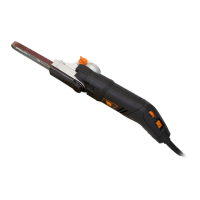SPECIFIC RULES FOR THE SANDER
8. SANDING THE WORKPIECE
Caution: when the machine contacts the workpiece it will have a tendency to grab and pull forward.
Resist the forward motion and keep the belt sander moving at an even pace. Never pull the tool
backwards over the workpiece. Sand in the direction of the grain whenever possible. Remove the
sanding dust between each grade of sanding sheet. Never leave the machine unattended while it is
still running.
9. SETTING DOWN THE SANDER
Wait for the belt to stop before setting the tool down. An exposed rotating belt may engage the
surface, leading to possible loss of control and serious injury. Always lay the sander on its side to
prevent accidents if the machine is inadvertently started.
10. UNPLUG YOUR SANDER
Ensure that the sander is disconnected from the main supply before servicing, lubricating, making
adjustments, changing accessories, or replacing sanding belts. Accidental start-ups may occur if
the tool is plugged in during an accessory change. Before plugging the tool back in, check that the
trigger is OFF.
11. REPLACING THE SANDING BELT
Replace the sanding belt as soon as it becomes worn or torn. Torn sanding belts can cause deep
scratches that are difficult to remove. Ensure that the sanding belt is the correct size for the machine.
After changing a sanding belt, rotate the belt to make sure it doesn’t hit any part of the tool.
12. CLEANING YOUR SANDER
Clean and maintain your tool periodically. When cleaning a tool, be careful not to disassemble any
portion of the tool. Internal wires may be misplaced or pinched and safety guard return springs may
be improperly mounted. Certain cleaning agents such as gasoline, carbon tetrachloride, ammonia,
etc. may damage plastic parts.
7

